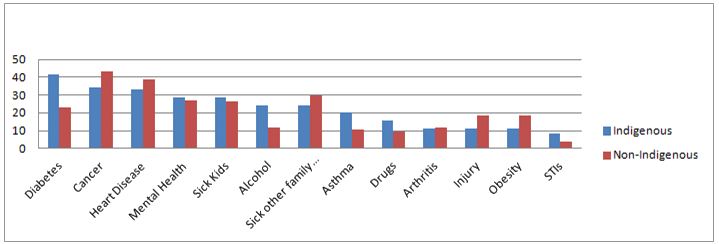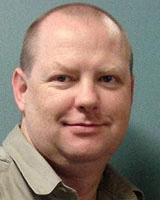In developed countries men's health is poorer than women's for a range of key indicators, and being an Indigenous man in Australia widens the gap substantially. In Australia the life expectancy for men and women is 78.7 and 82.6 years, respectively; however, Indigenous men's life expectancy is 67.2 years1. Men have higher rates of obesity and smoking and are more likely to engage in consuming quantities of alcohol that in the long term pose risks to health. The death rate from motor vehicle accidents is almost three times higher for men, and the rate of suicide is more than three times higher for men2. Establishing the rates of mortality and health inequality between the sexes is useful for identifying that men's health needs attention, and that Indigenous men's health needs particular attention. The Australian healthcare system is undergoing significant reform and there are a large number of policy initiatives aimed at 'closing the gap' between Indigenous and non-Indigenous disadvantage. The Council of Australian Governments has identified one of its six targets as closing the gap in life expectancy within a generation, by 20313.
Men's health-seeking behaviour has been suggested as one of the causes of poor outcomes, with men preferring to view their partner or friends as the primary source for help, rather than healthcare practitioners. Health-seeking or 'help-seeking' has been defined by Smith et al as the 'recognition of a health concern together with a range of actions that result, one of which is health service utilisation'(p81)4. This study aimed to identify differences in health concerns between men and women, and Indigenous and non-Indigenous people in an Australian mining town with the aim of targeting health promotion activities more effectively.
An intercept survey was conducted of residents in Port Hedland and South Hedland, the largest towns in the Pilbara region of Western Australia. Using census data, a representative quota sample was generated for age, gender, and Indigenous status. Based on this data, a sample size was calculated, and a recruitment schedule generated that was stratified by age groups (18-34, 35-54 and ≥55 years), gender and ethnicity. Participant recruitment continued until the number needed in each cell of the demographic grid was achieved. Once the number needed for a cell was completed, no further participants were sought in that age, gender and ethnic group.
To maximise the diversity of participants, researchers set up booths at the South Hedland Shopping Centre, the Boulevard Shopping Centre and the Wedge Street shopping zone between the hours of 09.00 and 17.00 on Thursdays and Fridays over a period of 6 months in 2010. This strategy aimed to capture people who were shopping after being paid and coincided with the cycle of government payments. In addition, a tent was set up at the Welcome to Hedland event and at the Matt Dann Theatre for evening showings. A group of seven trained interviewers which included two Aboriginal researchers conducted the interviews. Interviewers worked in teams of three to approach every adult person who passed the stall, and people were qualified for inclusion based on their meeting the quota inclusion criteria. Interviewers explained the purpose of the study and gained consent. Only participants over the age of 18 years were interviewed. Interviewers recorded the responses on the survey form which was colour coded for each of the quota. A series of cards were laminated with the options in size 20 font. Participants were asked a series of questions and given the card to indicate their answers against a range of options.
Interviewers recorded gender, Aboriginal or Torres Strait Islander self-identification status, and age in the ranges 18-34, 35-54 and ≥55 years. Interviewers asked whether people worked in the mining industry and in what capacity, such as contractor, professional, trades person, fly-in-fly-out worker; for those who did not, occupation was established according to 11 categories. People then confirmed their occupation in their own words. Interviews lasted on average 5 min.
Participants were asked a series of questions about health issues of concern to them. They were asked to identify three issues from a list of 13 issues which included local and national health priorities. Once participants had identified three issues they were asked to rank them in order of priority of most concern, second and third. In addition, participants were asked about their health-seeking behaviours including: where they sought health care, the last time health care was accessed, and what they accessed health care for. They were also asked about medication use, where they accessed medications and their knowledge of potential drug interactions, and whether they would be able to describe what they had taken. The health-seeking behaviour results have been reported elsewhere5. Data were entered into IBM SPSS (http://www-01.ibm.com/software/analytics/spss/) for analysis. Frequencies and percentages were used to describe the demographics of the sample and χ² test statistics were used to explore the relationship between health priorities, and gender and ethnicity.
Ethics approval
Ethics approval was obtained from the University of Western Australia Human Research Ethics Committee (RA/4/1/2409).
Three hundred and eighty participants completed the survey, 48% were male; 18.4% identified as an Indigenous person and 21% worked in the local mining industry. Men's and women's health priorities were generally similar but women prioritised 'sick kids' first, while men prioritised heart disease first (χ² =28.75 df=12 p=0.004). Ranked second for both genders was cancer. Third ranked for women was mental health issues, while for men mental health issues and diabetes were ranked equal third. The top three health concerns for Indigenous people were diabetes (41.4%), cancer (34.3%), and heart disease (32.9%); whereas for non-Indigenous people these were cancer (43.4%), heart disease (38.7%), and sick family members (30%) (Fig1). Approximately one-third of Aboriginal women identified alcohol misuse as a priority (32.4%) compared with non-Aboriginal women (6%). This was significantly different (χ²= 19.45 df=1 p=0.001). More than half the Aboriginal men identified diabetes as a priority (53%), compared with 24% of the non-Aboriginal men. This was also significantly different (χ²=10.04 df=1 p=0.002). No Aboriginal men identified injury as a health concern.

Figure 1: Priority health concerns (n & type) for Port Hedland and South Hedland residents, according to Indigenous/non-Indigenous status.
Discussion
The health concerns identified in this study were heart disease, cancer, diabetes and mental health, all important national health priority areas6. The four least concerning areas identified by the Indigenous participants included injury, obesity, arthritis and sexually transmitted infections (STIs), the first three of which are also national health priorities. The fourth (STIs) is of note because in the period 2009/2010 the Pilbara's reported crude rate for gonorrhoea for Indigenous people was 53 times that of non-Indigenous people (582.2/100 000)7. Non-Indigenous participants were least concerned about asthma, and drugs and alcohol misuse.
Injury is the commonest cause of hospitalisations in the Pilbara after renal dialysis7, yet for participants it was a low health priority, especially among Indigenous people. Alcohol consumption is the second highest cause of drug related hospitalisations in Australia after tobacco use8, and alcohol consumption has been on the rise in the Pilbara, reported to be 21.6 L per person in 2004-20059. It has also been reported that 80% of men in the Pilbara region drink alcohol at levels harmful to health7.
Limitations
The study has a number of limitations. The Pilbara is an area of intense mining and the towns of Port Hedland and South Hedland are the service centres for many outlying communities. The generalisability of the findings may be limited because the people who participated met the inclusion criteria but were not randomly selected. Participants may have identified some categories of health concern as social concerns (eg injury, alcohol consumption, obesity and STIs) rather than health priorities.
The health priorities identified by this study demonstrate that an in-depth study is needed into how people in the Pilbara region perceive health and social concerns, and also their understanding of the health consequences of lifestyle choices such as personal safety, alcohol consumption, obesity, unsafe sex. Current and future health promotion strategies should be tailored to address issues of prevalence and those resulting in high health-services usage, as well as those which are national health priorities.
References
1. Australian Bureau of Statistics. Measures of Australia's Progress. Canberra, ACT: ABS, 2010.
2. Australian Bureau of Statistics. Gender Indicators. Canberra, ACT: ABS, 2012.
3. Council of Australian Governments. Closing the gap in Indigenous disadvantage. (Online) 2013. Available: http://www.coag.gov.au/closing_the_gap_in_indigenous_disadvantage (Accessed 15 June 2013).
4. Smith J, Braunack-Mayer A, Wittert G. What do we know about men's help-seeking and health service use? Medical Journal of Australia 2006; 184(2): 81-82.
5. Ellis I, Deacon-Crouch M, Bhana A, Longley K, Voon N, Skinner T. Reporting of non-prescribed medication usage in remote Australia: health seeking habits in Port Hedland. Australian Journal of Rural Health 2013; 21: 350-351.
6. Australian Institute of Health and Welfare. National Health Priority Areas. (Online) 2013. Available: http://www.aihw.gov.au/national-health-priority-areas/ (Accessed 16 June 2013).
7. Wood N, Newton B, Bineham N, Lockwood T. Pilbara Health Profile. Perth, WA: Western Australian Country Health Services, Western Australian Government, 2012.
8. National Health and Medical Research Council. Alcohol and health in Australia. (Online) 2011. Available: http://www.nhmrc.gov.au/your-health/alcohol-guidelines/alcohol-and-health-australia (Accessed 12 March 2014).
9. Australian Bureau of Statistics. Western Australian Statistical Indicators: Spotlight on the Pilbara. Canberra, ACT: ABS, 2009.


